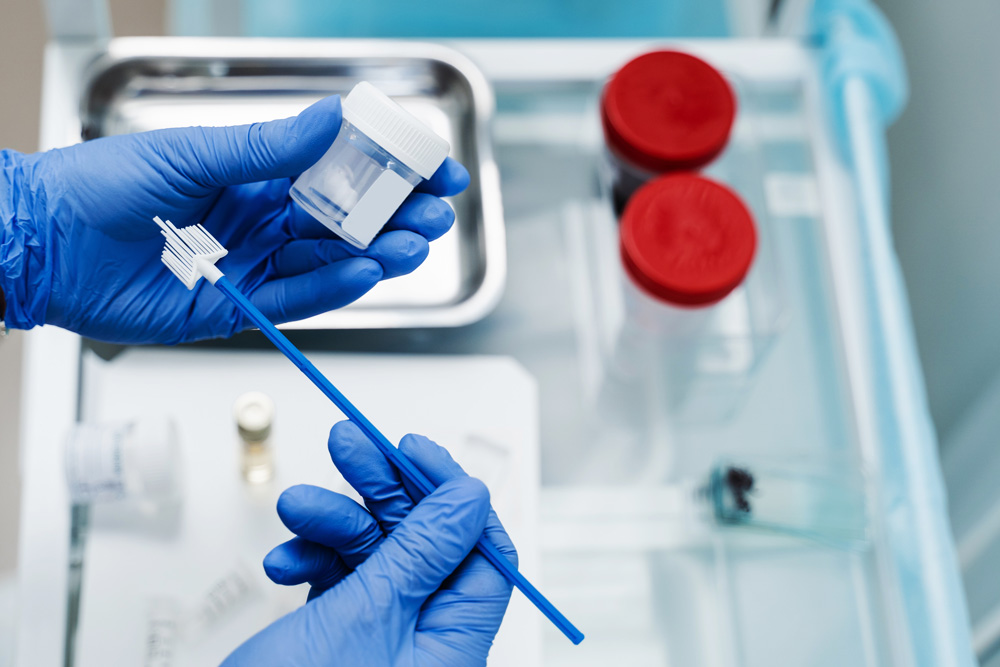HPV Test: Understand the Types and When to Get Tested
The human papillomavirus (HPV) is considered the leading cause of…
Continue reading


The human papillomavirus (HPV) is considered the leading cause of various anogenital and oropharyngeal cancers worldwide, representing a significant global impact on morbidity and mortality (1). For this reason, it is essential to seek up-to-date information and understand the most advanced methods available for HPV testing.
In 2022, estimates indicated that more than 830,000 new cancer cases and over 420,000 deaths were attributed to HPV infection. Among these, approximately 88.6% of diagnoses and 89.6% of deaths occurred in women, primarily due to cervical cancer, which accounts for around 75.6% of all HPV-associated tumors (1, 2).
In this context, early diagnosis has a substantial impact on reducing the morbidity and mortality associated with HPV-related cancers, especially cervical cancer. Detecting the infection at early stages allows interventions before progression to invasive disease, increasing cure rates and reducing the need for more aggressive treatments.
Understanding HPV goes far beyond knowing that it is a common infection. It involves comprehending its complexity, the different viral types, and, most importantly, how advances in diagnostic methods have transformed the prevention and management of HPV-associated diseases.
Below, you will find the most relevant information about this infection and HPV testing, which enables accurate and early detection of infection.
HPV is a DNA virus that infects epithelial cells of the skin and mucous membranes, and it is currently recognized as the most prevalent sexually transmitted infection worldwide. More than 200 HPV genotypes have been identified, divided between high-risk oncogenic types, such as HPV-16 and HPV-18, and low-risk types, such as HPV-6 and HPV-11.
While the former are strongly associated with the development of neoplasms such as cervical, vaginal, penile, vulvar, anal, and oropharyngeal cancers, the low-risk types are related to the formation of benign genital warts (3).
The primary route of HPV transmission is sexual contact—through vaginal, anal, or oral intercourse—as well as direct skin-to-skin contact during sexual activity without penetration. Although rare, vertical transmission from mother to newborn during childbirth can also occur.
Several factors contribute to persistent HPV infection, including early onset of sexual activity, multiple sexual partners, lack of condom use, smoking, immunosuppression, and co-infection with other sexually transmitted infections (STIs) (3, 4).
In most cases, HPV infection is asymptomatic and transient, being spontaneously cleared by the immune system within two years.
When HPV symptoms do occur, they may include anogenital warts—commonly associated with low-risk types—or precancerous lesions in infections caused by oncogenic types. Persistent infection with high-risk HPV is the main factor involved in the progression to intraepithelial lesions and invasive cancer (3, 4).
HPV testing, particularly in women, is essential for detecting infections caused by oncogenic types and for identifying early cellular changes that precede cervical cancer. Screening can be performed through cervical cytology (Pap test) or molecular tests that directly detect viral DNA.
International guidelines recommend periodic screening, a strategy proven to reduce both the incidence and mortality rates related to cervical cancer (5, 6).
HPV infection can be identified through different laboratory methods. Each technique has specific characteristics in terms of sensitivity, purpose, and clinical indication, as described below.
The Pap test, also known as cervical cytology, evaluates cellular changes in the cervix that may indicate precancerous lesions or the presence of malignant cells. Its primary purpose is cervical cancer screening. However, its sensitivity for detecting high-grade lesions (HSIL+) ranges between 50% and 70%, meaning that some HPV infections without visible cytological alterations may go undetected (7).
The molecular test based on the polymerase chain reaction (PCR) technique accurately identifies HPV DNA in cervical samples. It is highly sensitive and capable of detecting infections even in the absence of visible cytological changes (8).
This test may be requested either as a primary screening method or as a follow-up strategy in patients with abnormal cytology. It is particularly indicated for assessing infections caused by high-risk types such as HPV-16 and HPV-18. Its ability to detect infection at an early stage makes it a valuable tool in cervical cancer prevention (7, 8).
The Hybrid Capture test is a widely used molecular method for detecting HPV DNA in cervical samples. It uses RNA probes that hybridize with the DNA of 13 or 14 high-risk oncogenic HPV types, forming DNA-RNA hybrids that are subsequently detected through a chemiluminescent signal. This allows for the qualitative identification of the presence of high-risk HPV but does not discriminate specific genotypes (9).
Its main indications include cervical cancer screening (in combination with cytology), triage of indeterminate cytological results, and post-treatment follow-up of cervical lesions (7, 9).
HPV genotyping is a molecular test based on Multiplex Fluorescent PCR technology, in which different regions of the viral DNA are simultaneously amplified using primers labeled with specific fluorophores, enabling the identification of multiple viral types at once. This method allows for the detection and genotyping of the human papillomavirus (HPV), distinguishing between low-risk and high-risk oncogenic types.
Accurate HPV genotyping enables the identification of genotypes associated with a higher risk of progression to high-grade lesions and cervical cancer, serving as a valuable complementary tool to traditional cytological methods (10).
HPV testing is mainly indicated for women aged 30 years and older as part of primary screening, in combination with cytology (Pap test). It is also recommended in cases of indeterminate cytology, in patients with mild to moderate precancerous lesions (to predict regression or progression), and for post-treatment follow-up of patients previously diagnosed with cervical intraepithelial neoplasia or carcinoma.
The identification of HPV genotypes allows for more precise risk stratification, supporting clinical follow-up decisions (10).
HPV detection testing is performed by collecting cells from the female genital tract, using methods that include cervical cytology (Pap test) and sampling with a cervical or vaginal swab (6).
Traditional cervical cytology (Pap test) involves inserting a speculum to visualize the cervix, followed by collecting cervical cells with a brush or spatula. The sample is then sent for laboratory analysis and may be used for both cytology and molecular HPV testing.
Molecular HPV testing can be performed on samples collected with a cervical or vaginal swab, using specific brushes or swabs that can be transported in liquid or dry media, depending on the laboratory protocol (6).
It is recommended to avoid sexual intercourse, vaginal douching, creams, or topical medications within 48 hours prior to testing to minimize interference with sample collection and results. Fasting or other special preparation is not required beyond these recommendations.
The procedure performed by a healthcare professional may cause mild discomfort due to speculum insertion and cervical manipulation but is generally well tolerated. The collection typically takes 2 to 5 minutes, including preparation and sampling (6).
HPV screening is essential for preventing cervical cancer and follows specific guidelines based on age and risk factors. The American Cancer Society recommends initiating screening at age 25 for individuals at average risk (after evaluation of risk factors).
The preferred method is primary HPV testing (DNA-HPV) every 5 years. If not available, co-testing (HPV + cytology) every 5 years or cytology alone every 3 years is acceptable (7).
Between ages 21 and 29, only cytology every 3 years is recommended, as HPV infections are common and often transient in this age group. Screening can be discontinued at age 65 if there is a history of negative tests and no lesions in the previous 25 years (7).
Certain special situations require closer monitoring. Immunosuppressed individuals—such as those with HIV infection or organ transplant recipients—should begin screening by age 21, with shorter intervals between tests. Patients with a history of cervical lesions (CIN2+, AIS, or cancer) should remain under surveillance for at least 25 years, even after age 65 (7).
HPV vaccination does not eliminate the need for screening, as vaccines do not cover all oncogenic types. Women who have undergone total hysterectomy for benign causes and have no prior cervical lesions generally do not need continued screening. Exposure to partners with HPV does not change management, as infection is common and may remain latent for years (7).
HPV genotyping adds diagnostic value primarily in three clinical scenarios:
Genotyping allows for identification of high-risk HPV genotypes associated with precancerous lesions and cervical cancer, guiding decisions such as immediate referral for colposcopy or return to routine screening (11, 12).
When positive, the high-risk (hrHPV) genotypes for cervical cancer—according to international consensus and U.S. guidelines—are HPV 16, 18, 31, 33, 35, 39, 45, 51, 52, 56, 58, 59, 66, and 68. Among these, HPV 16 and 18 are the most oncogenic, responsible for the majority of cervical and other anogenital cancers.
Other high-risk genotypes, such as 31, 33, 35, 52, and 58, present an intermediate but significant risk for high-grade lesions (CIN2+). Genotypes 51, 56, 59, 66, 68, and 39 are considered lower-risk within the hrHPV group, with a reduced probability of progression to high-grade lesions, particularly in the context of normal cytology (11, 12).
Low-risk genotypes (e.g., HPV 6, 11, 42, 43, 44, 54, 61, 70, 72, 73, 81) are not associated with cervical cancer development and are not included in screening or genotyping tests recommended for cancer prevention (13, 14).

The HPV vaccine is indicated for the primary prevention of infections caused by both high-risk oncogenic HPV types and low-risk types associated with genital warts. The main benefits of vaccination include reducing infection rates for the HPV types covered by the vaccine, decreasing high-grade intraepithelial lesions (precursors of cancer), and consequently preventing cervical, anal, vulvar, vaginal, penile, and oropharyngeal cancers, as well as genital warts (15).
Vaccination is universally recommended for children and adolescents regardless of sex, ideally between ages 9 and 12, before the onset of sexual activity, when efficacy is greatest. For individuals not vaccinated during adolescence, catch-up vaccination is recommended up to age 26 (15).
For adults aged 27–45, vaccination may be considered based on shared decision-making, as the population-level benefit is smaller but may be relevant in specific risk scenarios. Immunocompromised individuals, including those living with HIV, should receive three doses regardless of age (15).
Even vaccinated individuals should continue cervical cancer screening according to current guidelines, since the vaccine does not protect against all oncogenic HPV types, and most women in the screening age group were not vaccinated during adolescence. Vaccination status does not change current screening recommendations (15).
Within its diagnostic portfolio, SYNLAB offers the following HPV-related tests:
The test uses Multiplex Fluorescent PCR technology, which enables simultaneous identification of different viral types, covering low-risk HPV (6 and 11) and high-risk oncogenic HPV (16, 18, 31, 33, 35, 39, 45, 51, 52, 56, 58, 59, 66, and 68).
Clinical indications:
This test can verify prior exposure to the virus or assess the immune response following prophylactic vaccination based on virus-like particles (VLPs). Although it does not replace direct viral DNA detection tests, it serves as a complementary tool that can provide valuable clinical and epidemiological information.
Accurate and up-to-date testing is essential for precise diagnoses and better treatment guidance. SYNLAB is here to help.
We offer diagnostic solutions with rigorous quality control to the companies, patients, and healthcare providers we serve. Present in Brazil for over 10 years, we operate in 36 countries across three continents and are leaders in diagnostic services in Europe.
Contact the SYNLAB team to learn about our available tests.
Below are the most common questions to help clarify key information about HPV.
HPV can be detected through cytology (Pap test), molecular tests such as PCR (DNA-HPV), hybrid capture, or genotyping.
A healthcare professional collects a sample from the cervix using a brush (swab) or spatula. The sample is then analyzed in the laboratory.
It is necessary to assess the HPV type (high or low risk). Depending on the case, the physician may recommend repeat testing, colposcopy, or continued medical monitoring.
The Pap test can reveal cellular alterations caused by HPV, even without identifying the viral type.
There is no specific “cure,” but the immune system can eliminate the virus naturally. However, these HPV types require close monitoring due to their high oncogenic potential.
No. HPV infects epithelial cells of the skin and mucous membranes; it does not circulate in the bloodstream.
Women aged 25 and older should undergo screening according to established guidelines. Immunosuppressed individuals or those with a history of cervical lesions require specialized follow-up.
No. Even vaccinated individuals must continue screening, as the vaccine does not protect against all oncogenic HPV types.
No. Routine HPV screening using molecular tests to detect high-risk HPV is not recommended for the general male population, whether through genital, oral, or anal samples. This guidance aligns with both American and international health guidelines.
Most HPV infections are transient and do not progress to significant disease. This limits the clinical usefulness of isolated testing for risk stratification or cancer prevention.
Men should seek medical attention if they develop genital, oral, or anal lesions that are: persistent, ulcerated, bleeding, painful and rapidly growing. These symptoms warrant clinical, cytological, and histopathological investigation, regardless of HPV test results.
References
(1) Zhang J, Ke Y, Chen C, Jiang Z, Liu H, Liu Y, Cao H. HPV cancer burden by anatomical site, country, and region in 2022. Sci Rep. 2025 Jul 1;15(1):21048. doi: 10.1038/s41598-025-06700-8
(2) Tian T, Fu L, Li Y, Yong L, Lu Z, He J, Yu W, Asilibek SL, Zhang Z, Zhen C, Li CX, Sang G, Wang K, Gong ZC, Zou H, Dai J. Global trends in the incidence of cancer attributable to human papillomavirus infection: A population-based study. Int J Cancer. 2025 Oct 15;157(8):1590-1599. doi: 10.1002/ijc.35520
(3) Zhang Y, Qiu K, Ren J, Zhao Y, Cheng P. Roles of human papillomavirus in cancers: oncogenic mechanisms and clinical use. Signal Transduct Target Ther. 2025 Jan 24;10(1):44. doi: 10.1038/s41392-024-02083-w
(4) Jensen JE, Becker GL, Jackson JB, Rysavy MB. Human Papillomavirus and Associated Cancers: A Review. Viruses. 2024 Apr 26;16(5):680. doi: 10.3390/v16050680
(5) Melnikow J, Henderson JT, Burda BU, Senger CA, Durbin S, Weyrich MS. Screening for Cervical Cancer With High-Risk Human Papillomavirus Testing: Updated Evidence Report and Systematic Review for the US Preventive Services Task Force. JAMA. 2018 Aug 21;320(7):687-705. doi: 10.1001/jama.2018.10400
(6) Medlineplus. Human Papillomavirus (HPV) Test. Disponível em: https://medlineplus.gov/lab-tests/human-papillomavirus-hpv-test/ Acessoem: 26/09/2025
(7) Fontham ETH, Wolf AMD, Church TR, Etzioni R, Flowers CR, Herzig A, Guerra CE, Oeffinger KC, Shih YT, Walter LC, Kim JJ, Andrews KS, DeSantis CE, Fedewa SA, Manassaram-Baptiste D, Saslow D, Wender RC, Smith RA. Cervical cancer screening for individuals at average risk: 2020 guideline update from the American Cancer Society. CA Cancer J Clin. 2020 Sep;70(5):321-346. doi: 10.3322/caac.21628
(8) Del Pino M, Alonso I, Rodriguez-Trujillo A, Bernal S, Geraets D, Guimerà N, Torne A, Ordi J. Comparison of the analytical and clinical performance of five tests for the detection of human papillomavirus genital infection. J Virol Methods. 2017 Oct;248:238-243. doi: 10.1016/j.jviromet.2017.07.009
(9) Mongia A, Pompeo G, Sani C, Burroni E, Fantacci G, Bisanzi S, Cellai F, Ventura L, Bottari F, Carozzi F. Hybrid capture 2 and cobas® 4800: Comparison of performance of two clinically validated tests for human papillomavirus primary screening of cervical cancer. J Med Screen. 2021 Dec;28(4):472-479. doi: 10.1177/0969141321992820
(10) Fernholz EC, Routman DM, Van Abel KM, Moore EJ, Ma DJ, Hunter DE, Bartemes KR, Lewis JS Jr, Wendlandt EB, Binnicker MJ. Detection, quantitation, and genotyping of human papillomavirus circulating tumor DNA by droplet digital PCR. J Clin Microbiol. 2025 Sep 10;63(9):e0058525. doi: 10.1128/jcm.00585-25
(11) Adcock R, Cuzick J, Hunt WC, McDonald RM, Wheeler CM; New Mexico HPV Pap Registry Steering Committee. Role of HPV Genotype, Multiple Infections, and Viral Load on the Risk of High-Grade Cervical Neoplasia. Cancer Epidemiol Biomarkers Prev. 2019 Nov;28(11):1816-1824. doi: 10.1158/1055-9965.EPI-19-0239
(12) Jiang W, Austin RM, Zhang H, He Y, Xu L, Wu X, Kuang W, Tong L, Li L, Zhao C. The Clinical Utility of Extended High-Risk HPV Genotyping in Women With ASC-US Cytology. Am J Clin Pathol. 2022 Oct 6;158(4):472-479. doi: 10.1093/ajcp/aqac073
(13) Perkins RB, Wentzensen N, Guido RS, Schiffman M. Cervical Cancer Screening: A Review. JAMA. 2023;330(6):547–558. doi:10.1001/jama.2023.13174
(14) Miller JM, Binnicker MJ, Campbell S, Carroll KC, Chapin KC, Gonzalez MD, Harrington A, Jerris RC, Kehl SC, Leal SM Jr, Patel R, Pritt BS, Richter SS, Robinson-Dunn B, Snyder JW, Telford S 3rd, Theel ES, Thomson RB Jr, Weinstein MP, Yao JD. Guide to Utilization of the Microbiology Laboratory for Diagnosis of Infectious Diseases: 2024 Update by the Infectious Diseases Society of America (IDSA) and the American Society for Microbiology (ASM). Clin Infect Dis. 2024 Mar 5:ciae104. doi: 10.1093/cid/ciae104
(15) Markowitz LE, Unger ER. Human Papillomavirus Vaccination. N Engl J Med. 2023 May 11;388(19):1790-1798. doi: 10.1056/NEJMcp2108502.
The human papillomavirus (HPV) is considered the leading cause of…
Continue reading
Female hormones play a central role in virtually every stage…
Continue reading
The moment a woman discovers she’s pregnant, a mother is…
Continue reading